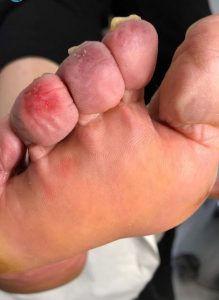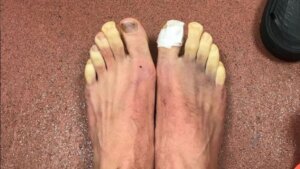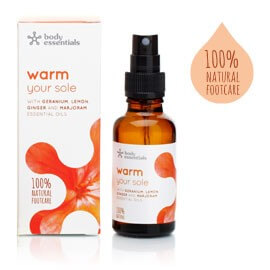"Chilblains? I thought they died out in the war!"
Myths we hear people say about chilblains:

Chilblains- picture courtesy of Nikki Claire Grant, First For Footcare, Scotland
“I can’t have chilblains because I don’t have a fire”
“Chilblains? I thought they died out in the war!”
“I can’t have chilblains because they don’t ever itch and chilblains itch don’t they?”
What are Chilblains?
Chilblains are small, swollen, reddened areas of skin: typically on the fingers or toes. Sometimes they itch due to the irritation caused by the disrupted blood supply. People who suffer with very cold fingers and toes when exposed to fluctuating cold/warm temperatures can be more susceptible to them. They were far more common before the days of central heating because the room temperatures would be more extreme: hot by the fire, cold and draughty by windows.
Sometimes the overlying skin at the site of a chilblain can breakdown resulting in an open sore or wound. This needs covering and protecting with a dressing until it heals. Chilblains can be associated with a circulatory condition called Raynauds syndrome, where the blood vessels in the fingers and toes constrict resulting in “white” digits like you see below.
Who remembers seeing these pictures of Liverpool player Adam Lallana after the game against Southampton on 11th Feb 2018?
Sky News reported he had spent 79 minutes on the touchline in the plummeting cold and this is how his feet looked afterwards.

Adam Lallanas feet after Southampton game 11-02-2018

Raynauds syndrome? What is that?
This is a fine, textbook example of Raynauds phenomenon. When exposed to cold temperatures, the smooth muscle of the tiny blood vessels in the extremities like toes, fingers, nose or ears go into a spasm. This restricts the blood supply and turns the toes white from lack of blood. The area feels numb until it starts to rewarm and the blood supply returns, it can be really painful and feel like “burning”. Chilblains are often associated with Raynauds Syndrome.
What should I do if I get Chilblains or Raynauds?
The key area to focus on if you suffer with this is prevention: think ahead and plan to get warm and stay warm.
Top tips to help you:
- Make sure you have lots of layers to keep your body heat inside
- 2 pairs of long thin socks rather than one thick pair (it is important to keep your whole leg warm, not just the ankle down)
- Wear extra tights or leggings under your trousers (or long John’s if you are truly commited to keeping warm)
- Make sure you are already warm before you go out, put gloves/mitts, scarves and coats on the warm radiator before you put them on (feels really cozy)
- Get some of the small gel heat pads to put in your gloves. (camping or outdoor shops supply these)
- Use thermal insoles in your shoes and boots (we will supply free if you come to our clinic, just ask)
- Consider fur lined boots to insulate your feet and ankles
- If you smoke it would help to stop, as nicotine causes smooth muscle contraction in your blood vessels and thus restricts blood supply (sorry, but its true)
- Still getting toes like these despite taking all these precautions? Gently rewarm slowly when you get home by using a hairdryer set on lowest heat setting and wave over your feet gradually
- If you are unlucky and still develop chilblains, get in touch with us at Lane Ends Podiatry we can help by applying some protective dressings and checking your blood supply for any signs of problems
What do we use in clinic for cold feet and toes?

Warm your sole, essential oil to prevent chilblains
If the skin is intact but toes or feet are cold, we use: “Warm your sole, Body Essential oil”
The action of massaging the oil into the skin helps to improve circulation. The warming effect of the ginger ingredient feels really lovely. People love it and it is one of our best selling products that we supply for this problem.
We also supply free thermal insoles to our clients to help them insulate their feet and prevent chilblains. Just ask next time you are in to see us. Great for putting into your wellies if you are out on a wet dog walk!
Coming soon: Warm wax therapy, watch this space!
Want more information?
Here are some links:
What are chilblains? NHS UK NHS Choices
National Institute for Health and Care Excellence, chilblains NICE guidelines
Remember to stay safe out there in any cold, wet, snowy or icy conditions. There is only one of you, and you are worth taking care of.
Until next time, hugz 🙂

